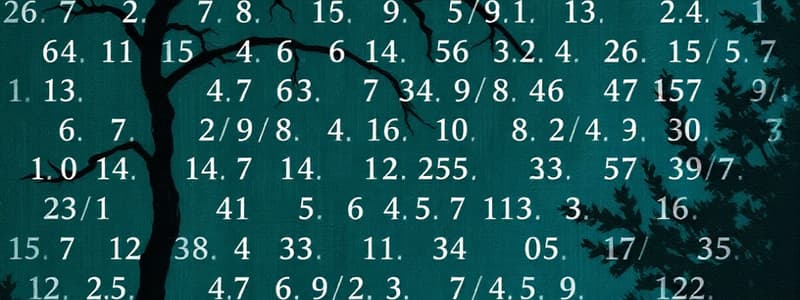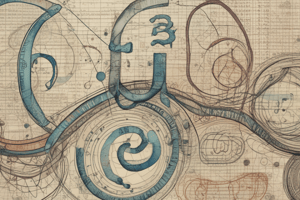Podcast
Questions and Answers
Which of the following represents the set of natural numbers?
Which of the following represents the set of natural numbers?
- {x + iy : x, y are real numbers and i = -1}
- {... -3, -2, -1, 0, 1, 2, ...}
- {1, 2, 3, ... } (correct)
- {a/b : a, b are integers and b 0}
Which of the following represents the set of integers?
Which of the following represents the set of integers?
- {a/b : a, b are integers and b 0}
- {1, 2, 3, ... }
- {x + iy : x, y are real numbers and i = -1}
- {... -3, -2, -1, 0, 1, 2, ...} (correct)
Which of the following represents the set of irrational numbers?
Which of the following represents the set of irrational numbers?
- Numbers that cannot be expressed as a fraction (correct)
- All positive whole numbers
- Numbers that can be expressed as a fraction
- All negative whole numbers
Which of the following represents the set of complex numbers?
Which of the following represents the set of complex numbers?
The set of natural numbers is a subset of the set of integers.
The set of natural numbers is a subset of the set of integers.
The set of rational numbers is a subset of the set of irrational numbers.
The set of rational numbers is a subset of the set of irrational numbers.
The set of real numbers is a subset of the set of complex numbers.
The set of real numbers is a subset of the set of complex numbers.
What is the relationship between the sets N, Z, Q, R, and C?
What is the relationship between the sets N, Z, Q, R, and C?
What is the definition of a function?
What is the definition of a function?
What is the domain of a function?
What is the domain of a function?
What is the range of a function?
What is the range of a function?
What is the domain of the function f(x) = 2?
What is the domain of the function f(x) = 2?
What is the range of the function f(x) = 2?
What is the range of the function f(x) = 2?
What is the domain of the function f(x) = x - 4 / x + 2?
What is the domain of the function f(x) = x - 4 / x + 2?
What is the range of the function f(x) = x - 4 / x + 2?
What is the range of the function f(x) = x - 4 / x + 2?
What is the domain of the function f(x) = (x - 2)(x + 2)?
What is the domain of the function f(x) = (x - 2)(x + 2)?
What is the range of the function f(x) = (x - 2)(x + 2)?
What is the range of the function f(x) = (x - 2)(x + 2)?
What is the domain of the function f(x) = (2x - 6)?
What is the domain of the function f(x) = (2x - 6)?
What is the domain of the function f(x) = (2x + 1) / ((x + 1)(x - 4))?
What is the domain of the function f(x) = (2x + 1) / ((x + 1)(x - 4))?
How does a function establish a set of ordered pairs?
How does a function establish a set of ordered pairs?
Flashcards
Natural Numbers
Natural Numbers
A set of all positive whole numbers, starting at 1 and increasing without limit. These numbers are used for counting and ordering.
Integers
Integers
A set of all whole numbers, including both positive and negative integers, and zero. They represent both positive and negative quantities.
Rational Numbers
Rational Numbers
A set of numbers that can be expressed as a fraction of two integers, where the denominator is not zero. They represent whole numbers and parts of whole numbers.
Irrational Numbers
Irrational Numbers
Numbers that cannot be expressed as a fraction of two integers. They cannot be represented as a terminating or repeating decimal.
Signup and view all the flashcards
Real Numbers
Real Numbers
The set of all rational and irrational numbers. They represent all possible numbers on a number line.
Signup and view all the flashcards
Complex Numbers
Complex Numbers
A set of numbers that includes the imaginary unit 'i', which is the square root of -1. These numbers can be expressed as a sum of a real and an imaginary part.
Signup and view all the flashcards
What is a set?
What is a set?
A collection of elements, where each element is unique and well-defined. Sets are denoted by curly braces.
Signup and view all the flashcards
What is a subset?
What is a subset?
A relationship between sets, where every element of one set is also an element of the other set. It is denoted by ⊆.
Signup and view all the flashcards
What is a function?
What is a function?
A rule that associates each element in a set called the ‘domain’ with a unique element in another set called the ‘range’.
Signup and view all the flashcards
What is the domain of a function?
What is the domain of a function?
The set of all possible input values for a function, represented by 'Df' or 'Dom(f).'
Signup and view all the flashcards
What is the range of a function?
What is the range of a function?
The set of all possible output values for a function, represented by 'Rf' or 'Ran(f).'
Signup and view all the flashcards
What is a constant function?
What is a constant function?
A function that assigns a constant value to every input. It has a horizontal line as its graph.
Signup and view all the flashcards
What is a quadratic function?
What is a quadratic function?
A function that involves the square of the input variable. Its graph is a U-shaped curve.
Signup and view all the flashcards
What is a square root function?
What is a square root function?
A function that involves the square root of the input variable. Its graph is a curve that starts at the origin and increases slowly.
Signup and view all the flashcards
What is an absolute value function?
What is an absolute value function?
A function that involves taking the absolute value of the input variable. Its graph is a V-shaped curve.
Signup and view all the flashcards
What is a rational function?
What is a rational function?
A function that involves a rational expression, where both numerator and denominator are polynomials. Its graph can have vertical and horizontal asymptotes.
Signup and view all the flashcards
What is the graph of a function?
What is the graph of a function?
The representation of a function using points plotted on a coordinate system based on ordered pairs (x,f(x)).
Signup and view all the flashcards
How to find the domain of a function?
How to find the domain of a function?
The process of finding the domain of a function by identifying when it is defined. It involves considering restrictions on the input values.
Signup and view all the flashcards
How to find the range of a function?
How to find the range of a function?
The process of finding the range of a function by determining the set of all possible output values. It involves analyzing the function's behavior over its domain.
Signup and view all the flashcards
How to sketch the graph of a function?
How to sketch the graph of a function?
The process of sketching the graph of a function based on its definition and properties. It involves plotting points and connecting them to form a curve.
Signup and view all the flashcards
How does a function relate to sets of ordered pairs?
How does a function relate to sets of ordered pairs?
The mathematical idea that a function can be represented by a set of ordered pairs (x,y), where x represents the input and y represents the output.
Signup and view all the flashcards
What are the restrictions on the domain of a function?
What are the restrictions on the domain of a function?
The process of identifying the limitations or restrictions on the input values of a function. It involves considering factors such as square roots, fractions, and logarithms.
Signup and view all the flashcards
How to determine the behavior of a function as x approaches infinity?
How to determine the behavior of a function as x approaches infinity?
The process of determining the behavior of a function as the input values approach infinity or negative infinity. It involves analyzing the function's growth or decay patterns.
Signup and view all the flashcards
How to find values that should be excluded from the domain?
How to find values that should be excluded from the domain?
The process of identifying any values of x that make the denominator of a rational function equal to zero. These values must be excluded fromthe domain.
Signup and view all the flashcards
How to simplify a function?
How to simplify a function?
The process of simplifying a given function by performing algebraic operations or using trigonometric identities. It involves expressing the function in a more compact or manageable form
Signup and view all the flashcards
How to analyze a function?
How to analyze a function?
The process of examining different aspects of a function, such as its domain, range, intervals of increasing and decreasing behavior, intercepts, and asymptotes. It involves understanding the function's properties and its graphical representation.
Signup and view all the flashcards
How to evaluate a function?
How to evaluate a function?
The process of applying a function to a specific input value. It involves substituting the input value into the function's formula and evaluating the result.
Signup and view all the flashcards
How to find the inverse of a function?
How to find the inverse of a function?
The process of finding the inverse of a function by swapping the roles of the input and output variables. It involves solving for the input variable in terms of the output variable.
Signup and view all the flashcardsStudy Notes
Sets and Numbers
- Natural Numbers (N): The set of positive integers: {1, 2, 3,...}
- Integers (Z): The set of whole numbers, including zero and negative numbers: {...-3, -2, -1, 0, 1, 2, 3,...}
- Rational Numbers (Q): Numbers that can be expressed as a fraction a/b, where a and b are integers and b ≠ 0. Examples: 1/2, -3/4, 5, 0.
- Irrational Numbers (I): Numbers that cannot be expressed as a fraction of integers. Examples: √2, π.
- Real Numbers (R): The set of all rational and irrational numbers. (R = Q ∪ I)
- Complex Numbers (C): Numbers of the form x + yi, where x and y are real numbers, and i = √-1. (C includes all real and imaginary numbers).
- Relationship between sets: Natural numbers are a subset of integers, integers are a subset of rational numbers, and rational numbers are a subset of real numbers; real numbers are a subset of complex numbers. (N ⊂ Z ⊂ Q ⊂ R ⊂ C)
Functions
- Definition: A relation from a set X to a set Y is a function if each element in X corresponds to exactly one element in Y.
- Domain (Df or Dom(f)): The set of all possible input values (x-values) for a function.
- Range (Rf or Ran(f)): The set of all possible output values (y-values) for a function.
- Example function types : Square root, absolute value, quadratic (x²), cubic (x³).
Studying That Suits You
Use AI to generate personalized quizzes and flashcards to suit your learning preferences.




